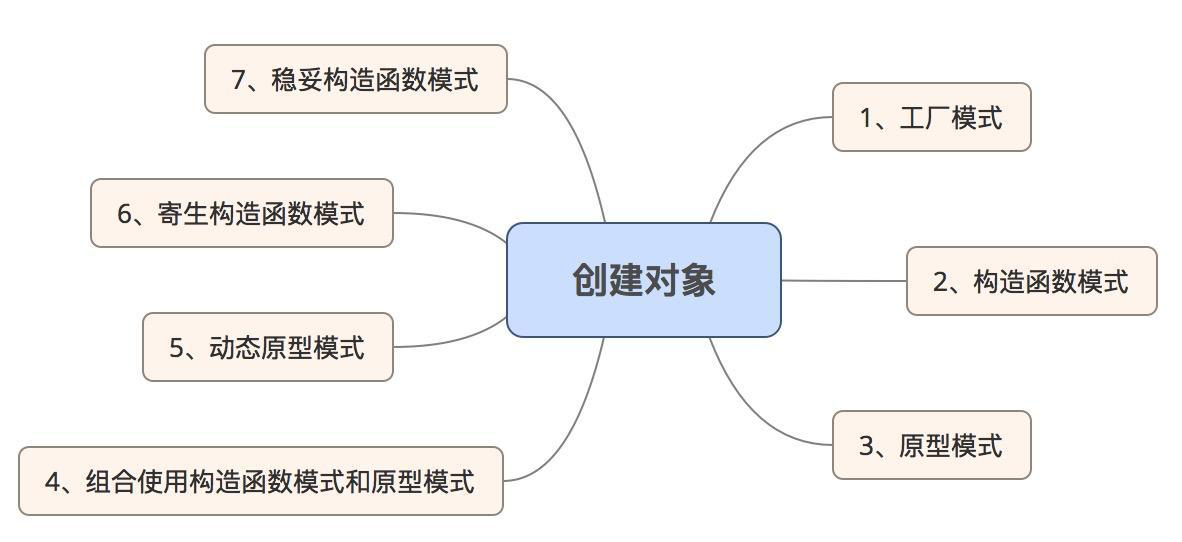创建类

1.工厂模式:解决了创建多个相似对象的问题,但却没有解决对象识别的问题(即怎样知道一个对象的类型)
|
|
2.构造函数模式:缺点是每个方法都要在每个实例上重新创建一遍
|
|
3、原型模式:(1)省略了为构造函数传递初始化参数这一环节,结果所有实例在默认情况下都将取得相同的属性值;(2)原型中的属性是被共享的,这种共享对于函数非常合适。
|
|
4.构造函数+原型模式:在ECMAScript中使用最广泛的一种方式
|
|
5.动态原型模式:在其他OO开发中看到独立的构造函数和原型时,很可能会感到非常困惑,此模式就是解决这种困惑的
|
|
不能使用对象字面量重写原型。如果在已经创建了实例的情况下重写原型,那么就会切断现有实例与新原型之间的联系。
6.寄生构造函数模式:在前述几种模式都不适用的情况下,可以使用寄生(parasitic)构造函数模式。这种模式的基本思想时创建一个函数,该函数的作用仅仅是封装创建对象的代码,然后再返回新创建的对象;但从表面上看,很像典型的构造函数。
|
|
除了使用new操作符并把使用的包装函数叫做构造函数外,这个模式跟工厂模式是一样的。
构造函数在不返回值的情况下磨人会返回新对象实例,而通过在构造函数添加return,可以重写调用构造函数时返回的值:
|
|
关于寄生构造函数模式,返回的对象与构造函数或着与构造函数的原型属性之间没有关系。所以可以使用其他模式的时候,不要使用这种模式。
7.稳妥构造函数模式:没有公共属性,而且其方法也不引用this的对象。最适合在一些安全的环境中(禁止使用this和new),或者在防止数据被其他应用程序改动时使用。
|
|
与寄生构造函数模有两点不同:1)新创建对象的实例方法不引用this;2)不使用new操作符调用构造函数;
与寄生构造函数模式类似,创建的对象与构造函数之间也没什么关系,因此instanceof操作符对这种对象也没有意义。
类的继承

1.原型链:实现继承的主要方法。
|
|

这个模式有两个问题:(1)共享属性;(2)创建子类型实例时,不能向超类的构造函数中传递参数。或者说没有办法在不影响所有对象实例的情况下,给超类的构造函数换地参数。鉴于有这两个问题,实践中很少会单独使用原型链。
2.借用构造函数:为解决原型中包含引用类型值所带来的问题
|
|
主要问题是:函数不能复用
3.组合继承:伪经典继承,避免了原型链盒借用构造函数的缺陷,成为最常用的继承模式
|
|
最大的问题就是会调两次超类型构造函数。
4.原型式继承:在没有必要兴师动众地创建构造函数,而只想让一个对象与另一个对象保持类似的情况下使用。
|
|
ECMAScript5通过新增Object.create()方法规范了原型式继承。
|
|
5.寄生式继承:会由于不能做到函数复用而降低效率
|
|
6、寄生组合式继承:只调用一次SuperType构造函数,开发人员普遍认为寄生组合继承是引用类型最理想的继承方式
|
|